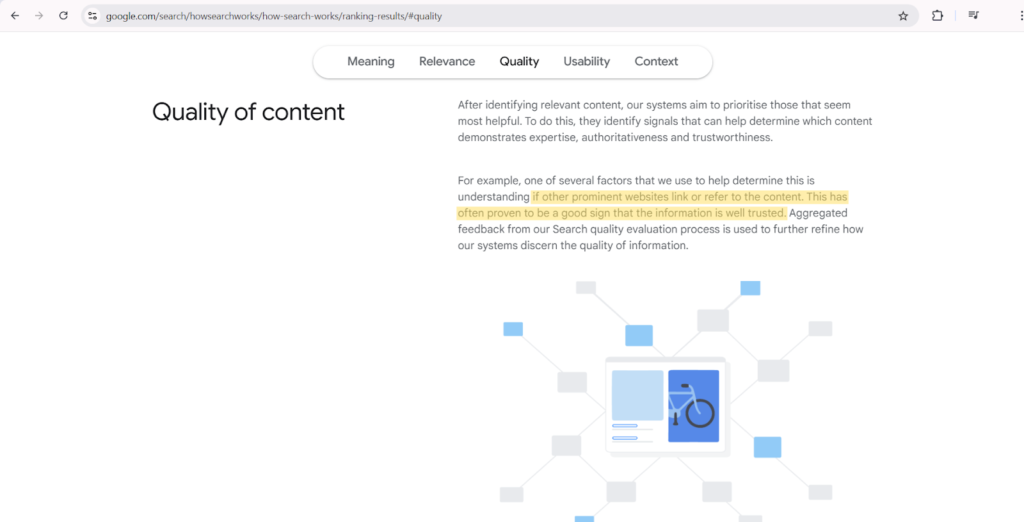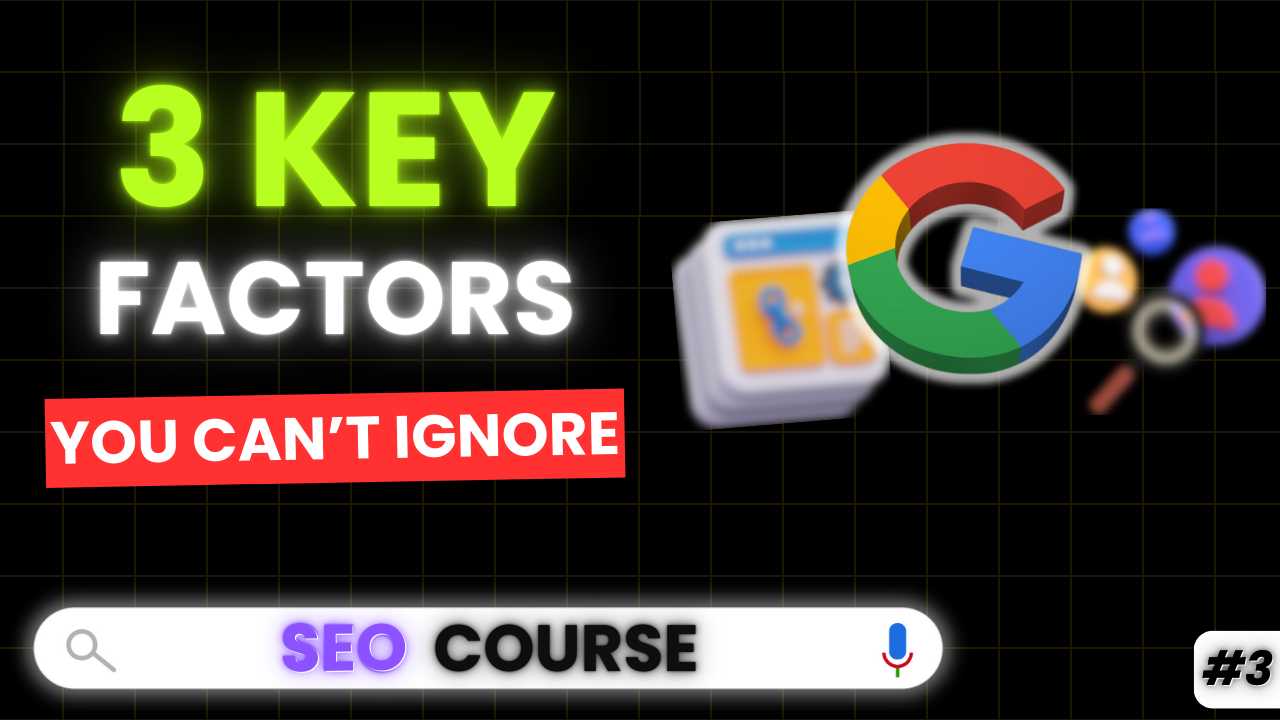Struggling to get your website to rank higher on search engines? You’re not alone! Many beginners feel overwhelmed by SEO’s complexity, but it doesn’t have to be that way. The good news is, there are a few core factors that can dramatically impact your SEO success.
Introduction
Welcome to the 3rd blog of SEO Course for Beginners by RankFast!
In today’s blog, we’ll be diving into three of the most important SEO factors you must understand and that you simply can’t ignore.
Whether you’re new to SEO, running a business, or looking to level up your skills, these concepts are going to make a huge difference in your rankings and online visibility.
We are putting in hours of work every day to build this course, so make sure to stay with us till the end. If this blog helps you, we would love to see you share it with others on social media!
So, let’s get started!
Section 1: Backlinks
Define Backlinks:
First, let’s talk about backlinks. You’ve probably heard of them before. Backlinks are links from a page on one website to another.
The easiest way to understand the value of a backlink is to think of them as votes of confidence from other websites. When a trusted site links to your content, it’s essentially saying: ‘Hey, this content is valuable!’ And Google takes note.
Why They Matter?:
Google has said on their How Search Works page, that if other prominent websites link to a page, that’s proved to be a good sign that information is well trusted.

The more high-quality backlinks you earn, the more credible your site appears to search engines. But remember it’s not just about quantity, but quality. Backlinks from reputable, authoritative sites will significantly boost your rankings and organic traffic.
Companies like Ahrefs also studied the effect of backlinks on search traffic. And found a clear positive correlation between backlinks from unique websites and a page’s organic traffic.

Practical Tips:
To get started, you can focus on guest blogging, building relationships in your industry, and creating shareable content like infographics or studies that others would naturally link to.
Don’t worry if you’re unfamiliar with these terms yet, because you can find out answers to all these terms on our YouTube channel. So, make sure to hit the subscribe button and stay ahead of others in your field.
Section 2: Search Intent
Define Search Intent:
Next, let’s talk about search intent. This is one of the most overlooked factors in SEO, which represents the reason behind a searcher’s query. Search intent simply means understanding the ‘why’ behind a user’s search query.
Why are they typing those words into the search bar?
Are they looking for information? Trying to buy something? Or are they comparing products?
And if you think of Google’s goal for search. Their job is to return the most relevant results for any given query.
Types of Search Intent:
There are four main types of search intent:
– Informational
– Navigational
– Commercial
– Transactional
For instance, if someone searches ‘best running shoes 2025’ they are likely in the research phase. On the other hand, ‘buy Nike running shoes online’ shows a strong intent to make a purchase.
So, with that said, you can discover search intent simply by looking at the top-ranking pages for the query you want to rank for.
Why Does It Matter?
For example, if you search for “best type of running shoes” You’ll see that the search results are mostly blog posts with a list of the best types of running shoes.

So if you try and rank a product page where you’re selling running shoes, you won’t be matching search intent and therefore, you won’t rank.
Now if we change the query to just “running shoes”
You’ll see that the dominant types of pages are ecommerce category pages so if you try and rank your blog post as the “best type of running shoes” then you probably won’t rank.

Because you’re not matching search intent, this is a critical concept to understand.
Practical Tip:
Use keyword research tools like Ahrefs or SEMrush to identify the intent behind your target keywords. Then, create your content to meet that intent.
Make sure your page delivers what the user expects, whether it’s a how-to guide, product review, or online store.
I’ll share a simple three-point checklist you can use to determine search intent for any query in the upcoming episodes of our SEO Course for Beginners by RankFast.
Section 3: Content Depth
Define Content Depth:
Finally, let’s discuss content in depth. In 2025 and beyond, shallow content just won’t cut it anymore.
Content depth means covering a topic comprehensively answering all potential questions a user might have in a single piece of content.
Search Engines are made up of computer programs. So they can’t actually read and understand text like you and I would.
Nevertheless, Google has poured billions of dollars into creating sophisticated technology that understands content to a certain degree. But it’s your job as a content creator to provide context about the subject.
Why It Matters?:
Google wants to serve users with the best possible results. If your content is thorough and provides in-depth answers, Google will favor it in the rankings.
For example, if you look at the top ranking pages for the quarry “how to drive a car”.
You’ll find that they talk about things like fastening your seatbelt, familiarizing yourself with the gas and brake pedals, adjusting your seat and mirrors and other things that a first-time driver may not know.
Basically, you want to be able to answer the searcher’s question the best you possibly can. Naturally, it should lead to content that has depth.
In simple words, instead of just writing a basic blog post about ‘how to start a blog’ dive deep into step-by-step guides, tool recommendations, case studies, and advanced tips. This shows that your content is a complete resource on the topic.
Now, it’s important to note that depth doesn’t always translate to length.
For example, a topic like “how to turn off iPhone” doesn’t need to and shouldn’t be long. In fact, the top-ranking page is only 189 words. However, the content itself solves the user’s query from start to finish.
Practical Tip:
To improve content depth, research your competition, see what they’ve missed, and provide additional value.
Use tools like AnswerThePublic or even Google’s ‘People also Ask‘ to identify further questions to address in your content.
Conclusion:
To wrap it up, focus on these three pillars of SEO: backlinks, search intent, and content depth. These are foundational strategies that will not only improve your rankings but also help you deliver a better experience for your users.
If you’re feeling overwhelmed or just want to focus on running your business while experts handle your SEO. We’ve got you covered! Reach out to RankFast, and we can take care of all your SEO needs.
Thanks for reading, and don’t forget to share about this blog to help others improve their SEO strategy, too.
Alright so the basics are in the book and it’s time to move on to the keyword research module which I will cover in the next blog. See you there!
Frequently Asked Questions (FAQs)
1. What are backlinks, and why do they matter for SEO?
Backlinks are links from other websites that direct users to your site. They act as a vote of confidence, signaling to search engines that your content is valuable and trustworthy. High-quality backlinks from reputable sites can significantly boost your rankings and organic traffic.
2. How can I build backlinks to my website?
Start by creating high-quality, shareable content like infographics, in-depth guides, or case studies. Guest blogging and building relationships with others in your industry can also help you earn backlinks naturally.
3. What is search intent, and how does it affect SEO?
Search intent refers to the purpose behind a user’s search query. Google aims to provide the most relevant results based on the user’s intent, whether they’re looking for information, trying to buy something, or researching a product. Aligning your content with the right search intent is key to ranking well.
4. How can I determine the search intent behind a keyword?
Analyze the top-ranking pages for your target keyword. For example, if blog posts are ranking for a query, users are likely looking for information. If product pages dominate, they may be looking to make a purchase. Tools like Ahrefs or SEMrush can also help identify search intent.
5. What is content depth, and why is it important?
Content depth refers to how thoroughly a topic is covered. Search engines favor content that provides in-depth answers and addresses all possible questions users may have on a subject. Content depth helps build authority and improves the chances of ranking higher.
6. Does content depth always mean writing longer articles?
Not necessarily. Content depth is about quality, not just length. While some topics may require long-form content, others might be sufficiently covered in shorter pieces. The key is to answer the user’s query comprehensively.
7. How can I improve content depth on my website?
Research what your competitors are missing and provide additional value. Use tools like ‘AnswerThePublic’ or Google’s ‘People Also Ask’ to uncover related questions and expand your content to cover these areas.
8. What are some common SEO mistakes to avoid?
- Ignoring search intent and creating content that doesn’t match what users are looking for.
- Focusing on low-quality backlinks rather than high-authority sites.
- Writing thin or shallow content that doesn’t fully answer user queries.
- Neglecting mobile optimization or page speed can hurt rankings.

Leave a Reply